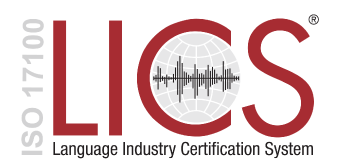Nowadays, software has become an essential part of our everyday lives. There’s hardly a service or product we use that wasn’t created with or uses software. On PCs, software can be found in the form of operating systems (OS) and other programs, ranging from office applications and multimedia apps to video games.
Software is also found on mobile devices like smartphones and tablets, and of course on the internet in the form of web applications. What’s more, many other devices and machines also contain software. Just think of household appliances, vehicles, industrial production systems, and so forth.
Most software is designed in English—which becomes a problem when it is meant to be distributed to users around the globe.
This is where software localisation comes in. You might be curious why there’s a separate process for software beyond mere translation, and how the software localisation process differs from app localisation or game localisation.
Let’s take a closer look!
Software localisation: Everything you need to know
Software localisation can be a lot more complex than standard professional translation services or website localisation. First, it involves translating a software interface and user messages from a source language into other languages—the target languages. Next, measurements, dates and currencies are localized according to the target language and region. And finally, the terminology is culturally adapted to the local culture of the target region.
Several other elements also usually have to be adapted as part of professional software localisation; these include:
- online help files,
- product documentation,
- license agreements,
- installation instructions, and
- user manuals.
A regular translation would render the words in the software into another language but not necessarily take into account the level of user-friendliness and meaningfulness of the interface for users in the target markets. Software localisation, on the other hand, adapts the content perfectly to the specific needs in each region and culture. It goes all the way down to adjusting the font size or widening menu items because some languages are naturally more verbose and therefore need more space than others.

Good software localisation goes even further and provides localized versions for each specific locale of the target language, so users can choose their own variety of their language. German, for example, can be broken down into standard German (DE-DE), Austrian German (DE-AT), or Swiss German (DE-CH). By the same token, a multilingual country like Switzerland would be assigned different languages—in this case, German Swiss (DE-CH), French Swiss (FR-CH), and Italian-Swiss (IT-CH)—but they would all share the same date and time, currency, and measurement conventions.
As you can see, software localisation is an elaborate process that requires an expert to ensure the best possible result for you and your end users. EHLION can give you just the support you need.
Drop us a line, and we’ll be happy to discuss the process and how it can be adapted to your needs.
With the above definition of software localisation, let’s look at the best practices of software localisation.
Software localisation best practices
When you are planning to have your software localized, keep in mind these software internationalization best practices:
Plan enough time
Schedule sufficient time for the localisation process during the software development stage to avoid a last-minute rush and allow enough time for all the process steps.
Make your design localisation-friendly
Everything should be designed in a way that it can later be adapted to different languages and regions without any engineering changes to the programming logic. Using the right structure and source code from the outset will save you time and additional costs later on. And lower translation rates are a definite plus!
Optimize your English test plan:
A solid test plan can be reused for other languages when testing the software functionality and user interface. Again, this will save time and costs down the track.
Allow space for expansion
As other languages may be more verbose and therefore longer than English (or shorter of course), allow for approximately 30% expansion in your interface design.
Make use of pseudo-localisation
This process replaces real text with dummy translations, helping you identify potential problems before investing in the actual localisation.
Avoid linked and single strings
As other languages have different conventions than English, it’s likely that the word order and grammatical elements such as gender or singular/plural will change. Having single or linked strings makes it harder to accommodate these differences.
Remember local adaptation
Don’t forget to check that all measurements, currencies, and time and date formats are correct for each target market.
Provide context
You’ll make life so much easier for the translator and ensure that the localized version is more accurate if you add comments to the strings that provide the context of each phrase.
Check icons
Symbols depicted on icons may need to be adapted too. An illustration that’s perfectly clear in one country may make no sense to users in another region.
Consult with an expert like EHLION
Hiring an experienced localisation expert is worth hiring to make your software go global. You’ll have peace of mind that best practices are adhered to and you’ll be sure to avoid potentially costly or embarrassing mistakes.
Benefits of software localisation
Having your software professionally localized can give you a distinct competitive advantage in the market. Going beyond merely translating your software will make your product more useful for your target customers and make you stand out from the competition. Local buyers are sure to thank you for it.
For international users, the most important aspect of a software is its user interface. The more idiomatically all details have been translated into the users’ languages, the easier it will be for them to navigate and use or operate your software. This enhanced user experience will likely drive user engagement and ultimately boost customer loyalty. And satisfied users will recommend your product and keep buying it. Naturally, this will increase your sales too.
Do you need book, manuals or legal document translations?
- Notarized translations
- Professional translations
Do you need translations of manuals or operating instructions?
- Translation of manuals
- Over 800 language combinations
Another advantage of having your software localized is that you will be faced with lower costs for support in the local markets. If the user interface is idiomatic and easy to use, this leads to a better customer experience and fewer issues and queries about the software. As a result, you get to enjoy savings in support costs.
Ultimately, your company will benefit from a global presence and international renown if you offer successfully localized products in multiple markets. Not only will this get you more customers, it will also establish your business as an authority and a trustworthy company, potentially around the globe.
Overview of benefits:
- competitive advantage in the target market
- increased usefulness and appeal to local buyers
- easier navigation of user interface
- enhanced user experience and loyalty
- international renown
- ultimately increased sales
The software localisation process
Software localisation is usually performed using computer-assisted translation programs. What’s more, translators working on software localisation need specific tools for editing (extracting, managing, merging) language strings in the computer code. And software localisation typically needs to integrate a variety of media, the software itself, in-context help, and any help systems, manuals, tutorials, and so forth.
While a regular translation comprises terminology research, editing, proofreading, and in some cases desktop publishing, software localisation includes additional activities such as localisation strategy consulting, multilingual project management, file format conversion, alignment and maintenance of translation memories, multilingual product support, and software and online help engineering and testing.
A software localisation project typically follows these process steps:
Source file extraction
Standard localisation programs support a variety of file formats. Some may require you to provide the content in the form of XLIFF (XML Localisation Interchange File Format) files. Check with your provider beforehand what will be required.
Selection of preferred translators and translation method
Work with your language services provider to choose the most suitable translators and method for your project. This can be server-based or offline, involving a single translator or a team of translators.
Quality assurance
Once the localized text has been delivered, it needs to undergo a quality assurance review to ensure its accuracy, appropriateness, and user-friendliness. EHLION offers such a professional quality assurance process as a matter of course.
Insertion of translated text into your code
Once you have imported the translated files back into your application, your software can be launched and tested in the foreign languages.
How can I get my software localized?
If you are wondering how to go about localizing your software and are unsure how to get the ball rolling, EHLION’s experienced software localisation team can help. We provide expert guidance through each and every step of the process to enable you to achieve professional results. And we make sure that every last detail of the final software product is perfectly tailored to your specific target markets.
With our team of experienced software translators, project management experts, and quality assurance staff, we’re ready to help as soon as you decide to kick off your localisation project! We’ll work closely with your software development team to ensure that your software and accompanying documentation make an impact in your target markets with their high quality and user-friendly design.
Software localisation in a nutshell
Software localisation is a sound investment. It’ll boost your credibility in multiple markets and ensure a much more enjoyable user experience for your customers. After all, a successfully localized software application looks and feels as though it was originally designed in the user’s own country and language.
Teaming up with a software localisation expert like EHLION is the best strategy for a smooth process from start to finish and a successful end product that will delight your users. Contact us today for a free consultation.









